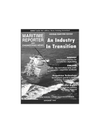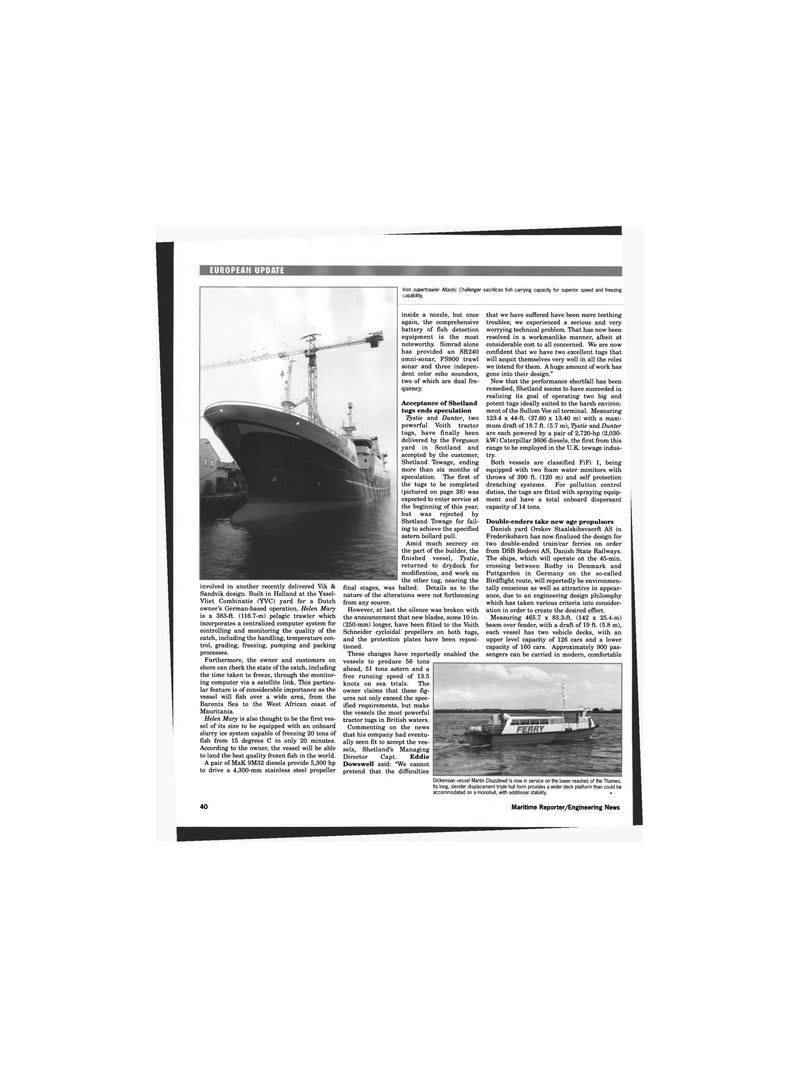
Page 40: of Maritime Reporter Magazine (September 1996)
Read this page in Pdf, Flash or Html5 edition of September 1996 Maritime Reporter Magazine
EUROPEAN UPDATE
Irish supertrawler Atlantic Challenger sacrifices fish carrying capacity for superior speed and freezing capability. r •5® involved in another recently delivered Vik &
Sandvik design. Built in Holland at the Yssel-
Vliet Combinatie (YVC) yard for a Dutch owner's German-based operation, Helen Mary is a 383-ft. (116.7-m) pelagic trawler which incorporates a centralized computer system for controlling and monitoring the quality of the catch, including the handling, temperature con- trol, grading, freezing, pumping and packing processes.
Furthermore, the owner and customers on shore can check the state of the catch, including the time taken to freeze, through the monitor- ing computer via a satellite link. This particu- lar feature is of considerable importance as the vessel will fish over a wide area, from the
Barents Sea to the West African coast of
Mauritania.
Helen Mary is also thought to be the first ves- sel of its size to be equipped with an onboard slurry ice system capable of freezing 20 tons of fish from 15 degrees C in only 20 minutes.
According to the owner, the vessel will be able to land the best quality frozen fish in the world.
A pair of MaK 9M32 diesels provide 5,300 hp to drive a 4,300-mm stainless steel propeller inside a nozzle, but once again, the comprehensive battery of fish detection equipment is the most noteworthy. Simrad alone has provided an SR240 omni-sonar, FS900 trawl sonar and three indepen- dent color echo sounders, two of which are dual fre- quency.
Acceptance of Shetland tugs ends speculation
Tystie and Hunter, two powerful Voith tractor tugs, have finally been delivered by the Ferguson yard in Scotland and accepted by the customer,
Shetland Towage, ending more than six months of speculation. The first of the tugs to be completed (pictured on page 38) was expected to enter service at the beginning of this year, but was rejected by
Shetland Towage for fail- ing to achieve the specified astern bollard pull.
Amid much secrecy on the part of the builder, the finished vessel, Tystie, returned to drydock for modification, and work on the other tug, nearing the final stages, was halted. Details as to the nature of the alterations were not forthcoming from any source.
However, at last the silence was broken with the announcement that new blades, some 10 in. (250-mm) longer, have been fitted to the Voith
Schneider cycloidal propellers on both tugs, and the protection plates have been reposi- tioned.
These changes have reportedly enabled the vessels to produce 56 tons ahead, 51 tons astern and a free running speed of 13.5 knots on sea trials. The owner claims that these fig- ures not only exceed the spec- ified requirements, but make the vessels the most powerful tractor tugs in British waters.
Commenting on the news that his company had eventu- ally seen fit to accept the ves- sels, Shetland's Managing
Director Capt. Eddie
Dowswell said: "We cannot pretend that the difficulties that we have suffered have been mere teething troubles; we experienced a serious and very worrying technical problem. That has now been resolved in a workmanlike manner, albeit at considerable cost to all concerned. We are now confident that we have two excellent tugs that will acquit themselves very well in all the roles we intend for them. A huge amount of work has gone into their design."
Now that the performance shortfall has been remedied, Shetland seems to have succeeded in realizing its goal of operating two big and potent tugs ideally suited to the harsh environ- ment of the Sullom Voe oil terminal. Measuring 123.4 x 44-ft. (37.60 x 13.40 m) with a maxi- mum draft of 18.7 ft. (5.7 m), Tystie and Hunter are each powered by a pair of 2,720-hp (2,030- kW) Caterpillar 3606 diesels, the first from this range to be employed in the U.K. towage indus- try.
Both vessels are classified FiFi 1, being equipped with two foam water monitors with throws of 390 ft. (120 m) and self protection drenching systems. For pollution control duties, the tugs are fitted with spraying equip- ment and have a total onboard dispersant capacity of 14 tons.
Double-enders take new age propulsors
Danish yard Orskov Staalskibsvaerft AS in
Frederikshavn has now finalized the design for two double-ended train/car ferries on order from DSB Rederei AS, Danish State Railways.
The ships, which will operate on the 45-min. crossing between Rodby in Denmark and
Puttgarden in Germany on the so-called
Birdflight route, will reportedly be environmen- tally conscious as well as attractive in appear- ance, due to an engineering design philosophy which has taken various criteria into consider- ation in order to create the desired effect.
Measuring 465.7 x 83.3-ft. (142 x 25.4-m) beam over fender, with a draft of 19 ft. (5.8 m), each vessel has two vehicle decks, with an upper level capacity of 126 cars and a lower capacity of 160 cars. Approximately 900 pas- sengers can be carried in modern, comfortable
Dickensian vessel Martin Chuzzlewit is now in service on the lower reaches of the Thames.
Its long, slender displacement triple hull form provides a wider deck platform than could be accommodated on a monohull, with additional stability. » 40 Maritime Reporter/Engineering News

 39
39

 41
41
